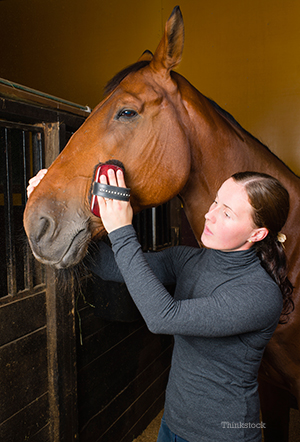
Grooming your horse can be one of the most satisfying parts of horse ownership. This daily routine is not only a bonding time for you and your horse but also a good opportunity to check them over for minor injuries or irritations they may have acquired in their stall or out to pasture.
Primary Tools:
- Mane & tail comb
- Curry comb
- Body brush (with stiff bristles)
- Body brush (with medium bristles)
- Finishing brush
- Hoof pick
- Damp cloth or sponge
Secondary Tools:
- Hoof dressing
- Mane & tail detangler
- Thrush treatment
- Swat (fly repellent)
- Grooming block
- Treats
Before grooming:
Tip: Before grooming be sure that your horse is tied in a safe location (with some type of quick release knot or system), and that your grooming tools/tote are not in a place where they could be accidentally kicked by your horse. An accident during grooming can make it a frightening experience for your equine friend.
The best way to start your daily horse grooming routine is by picking out your horse’s feet. Starting at the hooves gives you the opportunity to check for any changes in the hoof that could prevent you from riding that day, e.g., cracks, heat or even a lost shoe.
When running your hand down your horses leg to pick up the hoof also feel for any strange lumps, bumps or scrapes. Then remove all dirt, manure, or anything else (sometimes small rocks) in your horses hoof. Picking your horses feet everyday also keeps you on top of bacterial infections like thrush, which can be treated and prevented. Take time to notice (especially during the summer months) the inside for your horse’s legs for bot eggs; they attach to the hair and are small and yellow. Bot eggs should be removed with a grooming block to prevent the horse from ingesting them.
Now the brushing begins:
Using the curry comb in a circular motion, start from the neck and comb backwards (moving towards the rump of the horse). Currying loosens dirt, stimulates the skin, massages muscles, and most importantly distributes the natural oils in your horse’s skin called sebum which helps waterproof the hair and make it shine.
Tip: Find that really itchy spot on your horse with the curry comb. They just love to be scratched.
The next step is to locate your stiff bristled body brush. Starting again at the neck and moving back towards the rump, use a quick flicking motion to remove dirt and hair that the curry comb loosened. This normally results in a cloud of dust and hair floating in the air around you. After the stiff body brush you can use a medium bristled brush to remove anything that the stiff brushed missed.
Tip: Don’t forget to brush under your horse’s belly. Most days there will be dirt that has been kicked up under there.
The last of the body brushes is the finishing brush. It’s soft bristled and you can use long strokes from the neck heading back towards the rump to remove any remaining dust and really bring out the shine in your horses coat. The finishing brush can also be used on your horses face, under the throat, and on the ears.
Tip: You can also use a damp cloth or sponge to clean your horses face. Taking special care to remove dust and dirt from the area where the bridle will lay.
Last but not least, it’s time to tame the mane and tail. Start at the bottom in small sections until you can eventually comb from the top to the bottom without getting stuck in a knot. You can also apply any of the mane and tail detangler products that are on the market today to assist you in your efforts.
Tip: Separating the hairs with your fingers is a good way to remove any major tangles or dreadlocks before combing.
Above and Beyond:
If you are looking to go above and beyond the regular grooming experience there are a few other things to be done. You can apply hoof dressing to your horse’s hooves for a stronger, but still pliable hoof; hoof dressings also help to absorb and retain moisture.
Coat polishes can be applied to aid in repelling dust and give your horse that extra shine. Sunscreen is available and should be applied especially to horses with the pink skin on the end of their noses. Bug spray can also be applied after grooming.
Happy grooming everyone!
